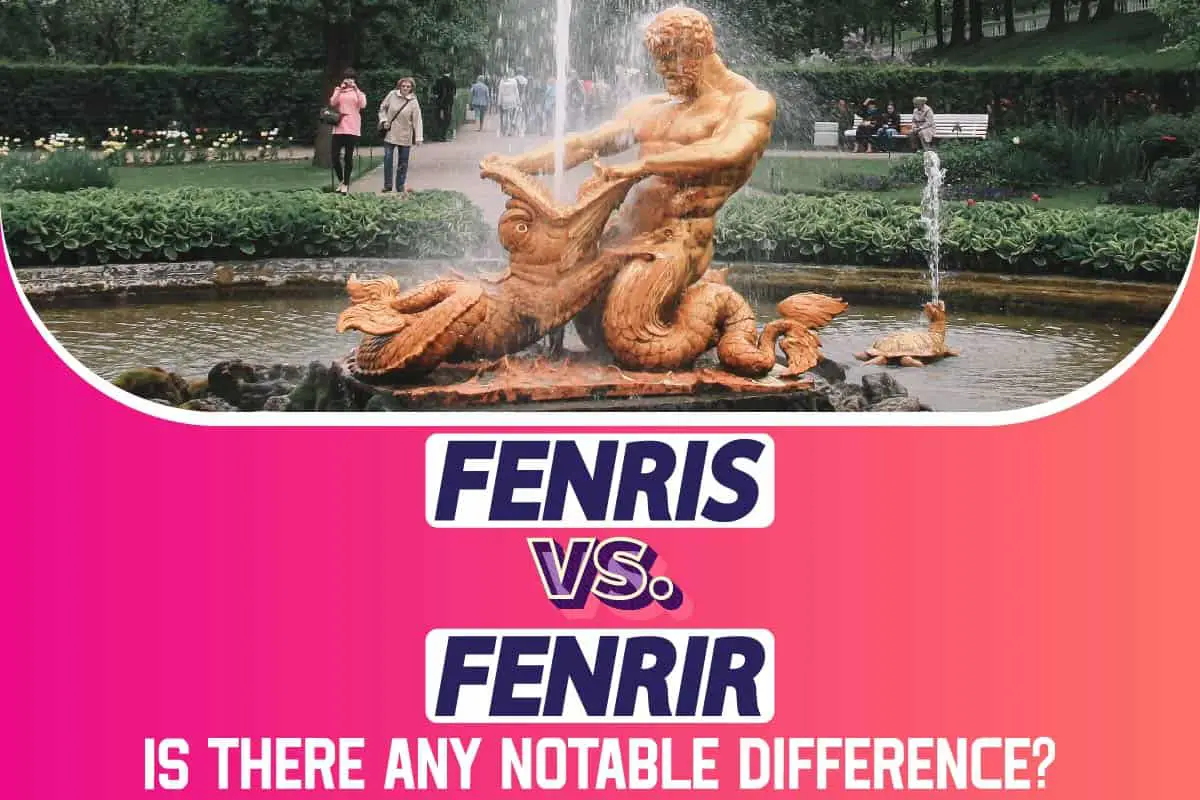In Norse mythology, there are several powerful beings. Some of these beings are the most powerful in the nine realms.
It is also impossible to talk about powerful beings without mentioning the Fenris or Fenrir. That’s because prophecy hinged the fate of the father of all gods in the hands of Fenrir or Fenris.
This article looks at the comparison between both Fenris and Fenrir. So, read for more understanding and detailed comparison.
Fenris vs. Fenrir, what’s the difference?
There is no difference between Fenrir and Fenris. In modern times, people use the two words interchangeably. Fenris is an alternative form of Fenrir. It is also called Fenrisulfr and translated as Fenrir’s wolf.
There are speculations that people pronounce Fenrir as Fenris because “Fenrir’s” wolf sounds close to Fenris. In Marvel’s Thor, they called Fenrir Fenris several times. People believe it is a modern way to shorten Fenrisulfr for easy communication.
Keep reading to learn more about this topic.
Who Is Fenrir?
Fenrir is the monstrous wolf of Norse mythology. He is the child of the giantess Angerboda and the god Loki. Because of who his parents were, everyone knew Fenrir was going to be evil. Fenrir’s strength, including his evil, caused fear.
The gods had to bind him with their magical chain to prevent him from being the nuisance they feared he would be. They made it from a woman’s beard, the sound of a cat’s footsteps, the breath of a fish, and many occultic items.
As they were bounding Fenrir with the chain, he bit off God Tyr’s hands. This action made them gag him with a sword. His destiny was to lie attached to a rock, which he did until Doom’s day- Ragnarok. However, he broke his bonds on this day and made it a memorable day for the gods.
There are different versions of Fenrir’s myth. One of the versions says that he would devour the sun and swallow Odin. Odin is the Chief God. And according to another legend, Odin’s son, Vidar, would avenge his death.
The myth says that Vidar would stab Fenrir in the heart. Another legend says he’ll kill Fenrir by pulling his Jaws apart. Poets wrote about different tales of Fenrir’s death and his breaking loose from the magical chains.
Fenrir got featured in a lot of 10th-century poems. He is also famous for being the biggest enemy of the Aesir.
Norse Mythology- The Capturing Of The Three Siblings
In Norse mythology, Loki and Angroboda had three children. These include Fenrir and his two siblings, such as Hel and Jormungandr. They were all born in Jotunheimen. And because of the prophecies that preceded them, their existence was a source of fear to the gods.
The prophecies said that the three children together because of their blood would significantly affect the gods. So, after the news of their existence got to Odin, he sent other gods to Jotunheim to bring the siblings to him, which they did.
The siblings arrived, and Odin threw Jormungandr into the ocean of Midgard. He gave Hel authority over the dead and sent her to Helheim forever. Odin decided to keep Fenrir close. Many say he wanted Fenrir close to ensure he didn’t have any opportunity to fulfill the prophecy.
So, Fenrir remained in Asgard. He caused great fear, and nobody had the guts to come near him. Only God Tyr could approach him. Even with all the supervision, Fenrir kept growing bigger and bigger as the days turned into months and months into years.
The gods noticed!
Norse Mythology- The Binding Of Fenrir
Fenris’ growth and size became a reminder of the prophecy that was looming over them. So, they tried to imprison him. The gods brought the chain Leyding to bind the wolf. The Aesir thought it would be wise to test the chains first on Fenrir.
Fenrir knew that the chain couldn’t hold him down. So, he let them bind him with it.
He freed himself from the chain almost immediately they bound him. Aesir was given a pat on his back for his initiative that proved they needed something more substantial to imprison Fenrir.
The second time around, the gods made a fortified chain. This chain was twice as strong as the first. They called it Dromi. The gods were confident that this new chain was going to get the job done. They again went ahead to repeat the process of binding him.
They trusted their work so much, believing that if Fenrir could break their new handiwork, then he might deserve fame and reverence after all. Fenrir allowed them to bind him again.
He knew the chain was strong, and it would be difficult for him to break out of it. But he liked the idea of shaming the gods, so he let them bind him and went through great pains to break the bind.
He struggled against the chain until he broke it into many pieces. This show of strength multiplied Odin’s and the other gods’ fear. They were so scared that Odin had to commission a few dwarves to make a binding that Fenrir wouldn’t be able to break.
The dwarves created a chain with different occultic items. Some of the things include the breath of a fish, the beard of a woman, etc. The combination of the various mystical items gave life to a silky ribbon. The silky ribbon was soft, and they named it Gleipner.
The dwarves delivered the ribbon to the Aesir. After the delivery, the gods decided to move Fenrir to Lyngvi. Lyngvi Island, located at Lake Amsvartnir, was unanimously chosen by the gods as the best place for Fenrir.
They took Fenrir to the island to show him how powerful the soft ribbon was and bind him for good. The gods loved to boast. So, they demonstrated the strength of the ribbon to Fenrir by pulling at it with their godly powers. It didn’t break.
Fenrir resisted being bound, noticing that the ribbon was not like the other binds. The gods tried to trick him into not resisting the restraints by lying that he could break out of them. But Fenrir wasn’t just strong; he was also brilliant. He made a deal with the gods for one of them to put their hand in his mouth while he got bound.
So that he would be sure that they were not lying about him breaking the bind, none of the gods agreed, except the god Tyr. They bound Fenrir with the soft silky ribbon, and he tried to break the restraint. But the more he tried, the tighter it became.
All the gods rejoiced except Tyr, who lost his right hand on that day. Fenrir bit it off out of frustration. They left Fenrir bound there until doomsday, when he fulfilled the prophecy, broke loose, and killed Odin.
Fenrir’s Power And Abilities
Fenrir was feared and revered for many reasons. Top on the list is him being a harbinger of Ragnarok. The belief is if he can kill Odin, then he is one of the most powerful beings in the nine realms.
The Aesir feared him for his strength and his power which he displayed many times.
He had three top abilities. They are:
Superhuman Strength:
Fenrir had superhuman strength. The strength he had was beyond what eyes had seen. He had more power than giants. Even his brother’s Jörmungandr didn’t have as much strength as the wolf had.
Fenrir is the only one that has gotten compared to some of the strongest Norse gods as he is destined to kill Odin. He isn’t just destined to kill Odin but also overpower the dead warriors of Valhalla. The Aesir fears him more than anything else.
Superhuman Durability:
Of all the stories told about Fenrir, his durability gets the most focus. The wolf’s superhuman durability takes him to a new level of scary. It’s his durability that got him through the dead of Valhalla.
His superhuman durability is what got him to fulfill the Odin prophecy. Fighting Odin, overpowering him, and finally killing him.
Shapeshifting:
Fenrir has some terrific transformation abilities. He displayed three known shape-shifting abilities.
- The first is Anthropomorphism. This ability involves him being able to turn into two different types of wolves.
- The second is digestive shape-shifting. Fenrir can take the form of the people he eats within 24 hours of eating them.
- His last shape-shifting ability is size altercation. He can get more prominent as he progresses in battle.
- Size altercation was how Fenrir fulfilled the sun-eating prophecy, according to legend.
Fenrir Sons
Fenrir had two sons, Sköll and Hati. There are several myths about the mother or mothers of Fenrir’s sons. Some say the mother of his sons is also his mother. Not much is recorded about their relationship with Fenrir. But they had roles to play in Ragnarok, and they were loyal sons.
When the gods kept Fenrir bound and imprisoned, Loki and Angroboda didn’t do anything about it, even though Sköll and Hati mentioned it. They both knew what the prophecy was, including the importance of Fenrir’s imprisonment.
Sköll and Hati show their loyalty by trying to free their father. Their attempt failed, and they got captured by Odin. Although attempting to release Fenrir didn’t work and was probably a mistake, their actions showed unwavering loyalty to their father.
Conclusion
Fenris and Fenrir are often used interchangeably to describe the Fenrisulfr. Fenrisulfr is a Norse mythology legend that, according to prophecy, would kill Odin. The Aesir feared him for his strength. You can also check out Fenrir’s abilities and strengths.
 Being Human
Being Human





